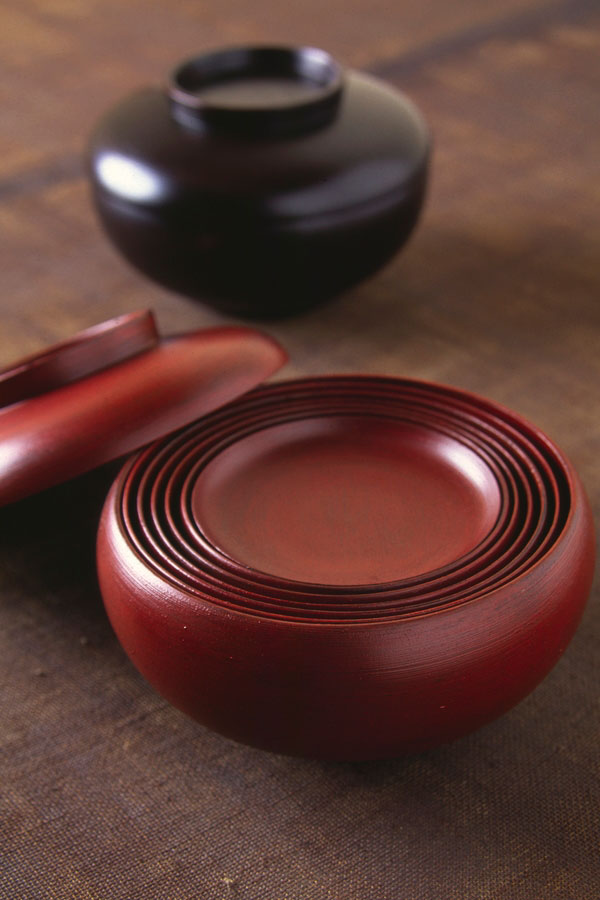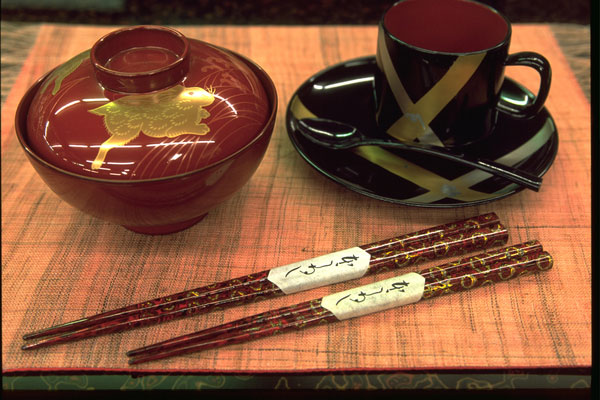 Photo:Shinshu・Nagano Prefecture Tourism Association
Photo:Shinshu・Nagano Prefecture Tourism Association
- Lacquerware
- Nagano
Kiso lacquerware Kiso shikki
The more it is used, the softer the glaze becomes
Warmth produced by the beautiful grain of the wood
Description
What is Kiso lacquerware ?
Kiso lacquerware (called Kiso shikki in Japanese) is produced in Kiso district, now the city of Shiojiri, Nagano prefecture. The area where this craft is produced is a plateau approximately 900 meters above sea level.
The climate has cool summers and very cold winters, making it ideal as a working environment for the application of lacquer. In addition, an abundance of local materials are available, such as the Japanese cypress and thujopsis, both of which are part of the Kiso goboku, or "Five Sacred Trees of Kiso".
Natural lacquer is applied to the wood materials like cypress, cercidiphyllum, and Japanese horse-chestnut. After washing in hot water, it is wiped with a soft cloth and stored in a location that is neither damp nor overly dry, away from direct sunlight.
Kiso lacquerware develops a warm glaze and becomes more solid the longer it is used. The main techniques are kiso shunkei, kiso tsuishu, and nuriwakero-ironuri. Kiso shunkei is a technique that brings out the beauty of the wood by directly applying the unrefined sap of the lacquer tree to the wood. With kiso tsuishu, a base coat is applied to the wood base then a pattern is applied with a pad that contains a large quantity of lacquer. With nuriwakero-ironuri, multiple kinds of colored lacquer are used to paint geometrical patterns in different colors, and the surface is carefully polished after drying the final coat.
History
 Photo:Shinshu・Nagano Prefecture Tourism Association
Photo:Shinshu・Nagano Prefecture Tourism Association
Kiso lacquerware was developed in Shiojiri in Nagano both due to the production area's topography and long-held importance as a location for transportation.
Production of the lacquerware began at the start of the 17th century, having developed due to the patronage of the Owari Tokugawa clan in the Edo period (1603-1868), and become a popular souvenir for people travelling on the Nakasendo, a road which connected Edo (ancient name for Tokyo) to Kyoto.
In the early part of the Meiji period (1868-1912), rust clay that could be used when applying undercoat was discovered, which made lacquerware easier to produce. As rust clay includes a large amount of iron, it enabled the production of more solid lacquerware than that of other production areas, and Kiso lacquerware became nationally well-known as a result.
During the post-war growth period, a large variety of products were produced, including items not essential in everyday life like high-quality furnishings used in Japanese and Western-style hotels.
General Production Process
- 1. Wood processing
This is a step to make a wood base out of solidified wood that has been completely dried naturally. The type of tree is selected based on the size and shape of the finished product. In order to ensure a beautiful and straight finish for the wood, the presence of a woodworker, who can finish it according to the measurements, is essential.
- 2. Undercoating
Before the wood base is sent out for the coating process, an undercoating is made. A gray paste called kokuso made of a rice flour and raw lacquer mix, is made. Although it is not considered to be part of the final product, the quality of the production of the first coat is an important step to the durability and ease-of-use of the final product. The undercoating paste is carefully applied in order to remove any crevices and unevenness in the wood.
Kiso shunkei is a technique in which a first coat is not applied and raw lacquer is repeatedly rubbed in and soaked into the wood, resulting in a beautiful wood grain.
- 3. Intermediate coating
An intermediate coating of raw lacquer is carefully applied to ensure that no dust sticks.
- 4. Printing
An uneven pattern is applied using a printing tool made of cotton called a tanpo.
- 5. Colored lacquering
Colored lacquer is made by mixing a pigment into the lacquer and different colors are layered on top of each other. Each coat is dried before another coat is applied, and this process is repeated approximately twelve times.
When using the nuriwakeru-ironuri method, several kinds of colored lacquer are used in order to paint a geometrical pattern in different colors.
- 6. Polishing
After the color lacquer has completely dried, the item is polished with a grindstone and sandpaper to bring out the pattern. The beauty of the pattern and the appearance of the base coat depends on the amount of strength applied when polishing. The hue and the individuality of the pattern depends on the craftsman. The polishing can be a showcase for the artisans' skills because they are needed to bring out beautiful patterns like annual tree rings. As multiple layers of lacquer coating is applied, the item becomes easier to use and any scratches are made less obvious.
Kiso tsuishu has become popular as the leading example of Kiso lacquerware technique during the postwar period. This is a technique in which a tanpo is used to repeatedly coat the uneven part of the pattern with color lacquer approximately twelve to eighteen times. As multiple layers of coating are built up, the surface of the color lacquer becomes flat and a grindstone is then used to polish the surface.
- 7. Polish mixture
A polish made of coal dust, oil and polishing powder is applied.
- 8. Raw lacquer
After polishing the wood, cotton soaked in raw lacquer is used to repeatedly paint until the wood surface shines. This is a repetitive task that requires patience, as the painting must be wiped before the lacquer has dried, before being painted and wiped again. The resulting appearance is popular for its simplicity and warmth of the wood grain. It is used in furniture, trays, and for the tabletops of kotatsu (heated tables).
- 9. Finishing touches
Articles are polished with cotton covered in a mixture made of polishing powder, ground antlers, and canola oil.
Where to Buy & More Information
Kiso Kurashi No Kogeikan
-
Address
-
Tel.+81-264-34-3888
-
Business Hours9am to 5pm
-
Website
See more Lacquerware
- Wajima lacquerware
- Kamakura-bori lacquerware
- Tsugaru lacquerware
- Aizu lacquerware
- Yamanaka lacquerware
- Kawatsura lacquerware
- Echizen lacquerware
- Joboji lacquerware
- Kiso lacquerware
- Hidehira lacquerware
- Kagawa lacquerware
- Ryukyu lacquerware
- Takaoka lacquerware
- Wakasa lacquerware
- Hida-shunkei lacquerware
- Ouchi lacquerware
- Kanazawa lacquerware
- Kishu lacquerware
- Kyo laquerware
- Odawara lacquerware
- Naruko lacquerware
- Niigata lacquerware
- Murakami carved lacquerware































































































































































































































































































